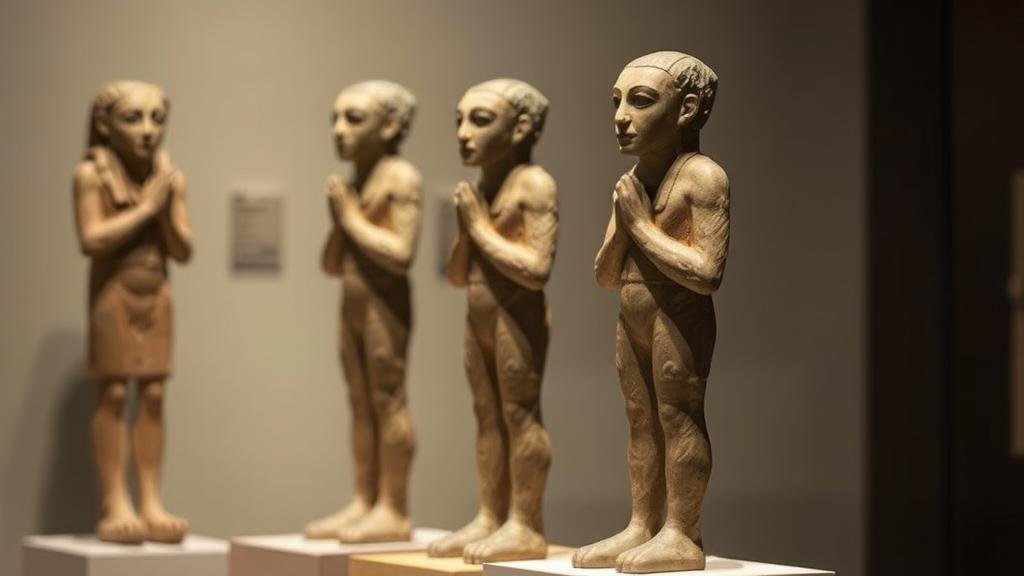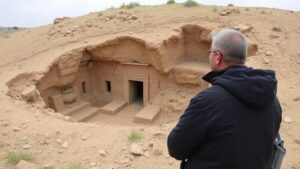Investigating the origins of the “Ubaid Figurines,” strange humanoid statues from ancient Mesopotamia.
Investigating the Origins of the Ubaid Figurines
The Ubaid figurines are a captivating archaeological find from ancient Mesopotamia, specifically dating back to the Ubaid period, which spans approximately from 6500 to 3800 BCE. Discovered mainly in southern Mesopotamia, these humanoid statues, often adorned with intricate headdresses and elaborate attire, provide significant insights into the culture, beliefs, and artistic expressions of early urban societies in the region. This article will explore the origins, characteristics, and cultural significance of these enigmatic figurines.
A Brief Overview of the Ubaid Period
The Ubaid period marks a critical phase in the development of Mesopotamian civilization. It is characterized by the emergence of the first complex societies and the introduction of advanced agricultural practices. The Ubaid culture is also noteworthy for its distinctive pottery and architectural innovations, including the construction of temples and the development of the first large settlements.
- The Ubaid period is commonly divided into four main phases: Early Ubaid (6500 – 5300 BCE), Middle Ubaid (5300 – 4700 BCE), Late Ubaid (4700 – 4200 BCE), and Final Ubaid (4200 – 3800 BCE).
- Notable archaeological sites include Eridu, Ur, and Bir ibn Humayd, where many figurines have been unearthed.
Ubaid figurines primarily depict human figures, often representing women, as seen in the prevalence of fertility symbols and motifs. These small statues typically range from a few centimeters to about 30 centimeters in height, crafted from clay and sometimes adorned with colored pigments.
- Materials: The figurines are predominantly made from baked clay. Some exhibit traces of paint or are intentionally left unpainted to emphasize the clay’s natural texture.
- Designs: While many figurines tend to have exaggerated features, such as large eyes and curvaceous bodies, they reflect the cultural ideals of beauty and femininity prevalent during that time.
- Functionality: Scholars debate the primary function of these figurines. They may have served religious purposes, possibly as votive offerings or fertility symbols, or as toys for children. The ambiguity surrounding their purpose continues to provoke interest and research.
Symbolism and Cultural Significance
The Ubaid figurines are often interpreted as embodiments of fertility, motherhood, and the transition into urban life. r presence in various archaeological contexts suggests they played a role in rituals or community activities.
- Fertility Rites: The recurring theme of fertility in these figurines supports theories that they may have been used in religious practices aimed at securing agricultural abundance and prosperous childbirth.
- Social Status Indicators: Some figurines have been found in elite burial contexts, indicating they could also signify social differentiation within Ubaid society.
Comparative Analysis with Contemporaneous Cultures
When compared to similar artifacts from neighboring regions, the Ubaid figurines stand out in their unique motifs and craftsmanship. For example, the figurines from the nearby Halaf culture (6000 – 5000 BCE) often depict less exaggerated forms and reflect different social structures and beliefs.
- Halaf Figurines: These are typically more abstract and less focused on female forms, suggesting diverse cultural narratives around femininity and fertility.
- Proto-Elamite Artifacts: Located in present-day Iran, these artifacts showcase a variety of human and animal figures, which underscores development across regional cultures and their interactions.
Modern Implications and Research
The study of Ubaid figurines has crucial implications for understanding the evolution of art, culture, and social structures in early civilizations. Continued excavations and advancements in technology, such as 3D imaging and chemical analyses, are enhancing discussions around their origins and purposes.
Recent advancements in comparative archaeology have also underscored the importance of collaborative studies across regions, allowing for a more comprehensive understanding of Mesopotamian developments during the Ubaid period.
Actionable Takeaways
For those interested in exploring the world of archaeology and ancient cultures further, the following actions can be beneficial:
- Engage with archaeological journals and publications to stay informed on the latest discoveries and scholarly debates regarding Ubaid figurines and Mesopotamia.
- Visit museums that feature collections of ancient Mesopotamian artifacts to gain visual and contextual understanding of these remarkable statues.
- Participate in workshops or lectures on ancient Mesopotamian cultures to deepen your knowledge and connect with like-minded individuals.
To wrap up, the Ubaid figurines are not mere relics of the past; they are intricate storytellers of a civilization that laid significant foundations for future societies. By continuing to investigate and analyze these captivating artifacts, we unearth not only their historical context but also the shared human experiences that resonate through time.



